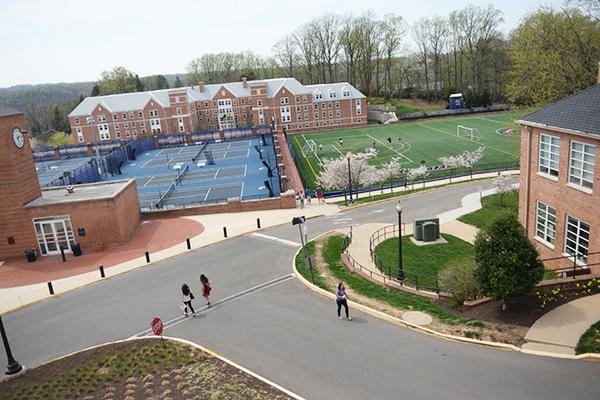While about a quarter of freshmen get housing assignments on the Mount Vernon Campus, most don’t know what to expect.
That’s partly because GW does not showcase the 23-acre suburban campus to prospective students and parents who often avoid making the 15-minute drive there, a consulting company said last week.
GW is now searching for ways to promote its majority-freshmen campus. Administrators are weighing ideas like a virtual tour for families who see GW as just one more stop in a string of campus tours. Consultants said that mindset leaves families with an incomplete picture of some of GW’s best academic programs.
“If a family is coming to Foggy Bottom but we can’t get them to sit in traffic or take the shuttle because they’re rushing to another school, then we need to make sure we tell that story while we have them in front us,” said Jeff Kallay, the CEO of the admissions consulting company Render Experiences.
GW hired the company last fall to study the effectiveness and appeal of the University’s tours, information sessions and welcome center.
Laurie Koehler, senior associate provost for enrollment management, said in an email that visiting both campuses makes prospective students and families understand that GW has “the best of both worlds and two experiences in one – the bustle of the city and a cozy campus.”
The company also said GW should focus more on its coveted academic cohorts like the University Honors and Women’s Leadership programs, which are partially housed on the Vern and have helped recruit top students away from competitor colleges. But if those students don’t see the campus, they are less likely to hear about those programs.
“How do you blend the two campuses, especially when the Mount Vernon Campus is becoming more predominant in the student experience?” Kallay said. “I think a lot of families aren’t going to see it.”
GW does not track how many students tour the Vern, spokeswoman Maralee Csellar said.

About 37,000 people have visited GW so far this academic year, a 7 percent increase from four years ago. GW has also seen its largest-ever visit numbers this April, according to admissions office data.
Other universities with multiple campuses, such as Duke University, also struggle to draw students to tour both areas.
Duke houses all freshmen on its historic East Campus, but most students won’t visit that area until they are already admitted, dean of admissions Christoph Guttentag said.
Guttentag said admissions considered adding a second office to the East Campus and a shuttle to take families on tours. Officials may also produce a video to show both campuses.
“The logistics are very difficult,” Guttentag said. “What we’ve found is even if we want to have people take a tour of East Campus because that’s where the first-years live, they still want to tour West.”
GW’s Mount Vernon Campus features athletic fields, a library, six residence halls, two dining halls and a 150-seat black box theater for student productions. GW has poured $60 million into renovating the campus’ two largest buildings – West and Ames halls – over the last four years.
Associate professor of theater and dance Mary Buckley said students miss what makes the campus unique if they don’t visit it in person.
“There are many little facets of Mount Vernon that are not captured in their entirety,” said Buckley, who also teaches in the Women’s Leadership Program. “If you only go to Foggy Bottom, you don’t know the full range of opportunities and experiences you might select.”
She added the University could draw families to the Vern by offering incentives like free parking, a lunch in West Hall or giveaways in Eckles Library.
More freshmen now live on the Vern with the opening of West Hall in 2010, which houses about 300 freshmen. All of the University Writing courses – a requirement for all freshmen – are also taught exclusively on the Vern.
Cecily Dreyfuss, an incoming freshman from New York City, said she decided to live on the Vern next year after her tour guide described the tight-knit community.
“It felt cozy,” Dreyfuss said, who hopes to live in Cole Hall next year. “That was something I was really looking for and I was excited.”








